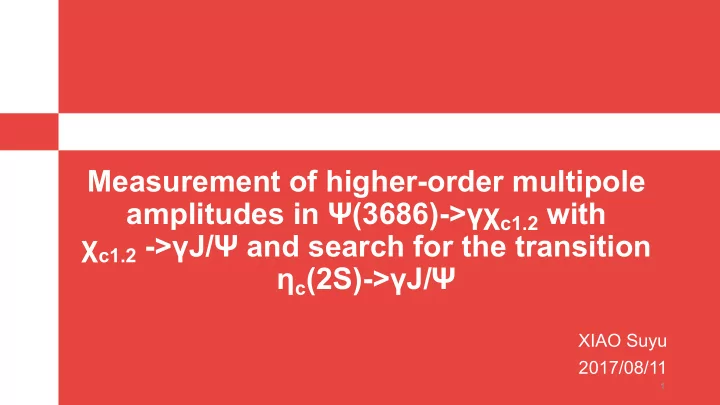

Measurement of higher-order multipole amplitudes in Ψ(3686)->γχ c1.2 with χ c1.2 ->γJ/Ψ and search for the transition η c (2S)->γJ/Ψ XIAO Suyu 2017/08/11 1
INTRODUCTION 106 million ψ(3686) events are collected with the BESIII detector amplitudes for the decay Ψ(3686)->γχ c1.2 ->γγJ/Ψ beyond the dominant electric-dipole amplitudes normalized magnetic-quadrupole amplitude for Ψ(3686)->γχ c1.2 ->γγJ/Ψ normalized electric-quadrupole amplitude for Ψ(3686)->γχ c2 ,χ c2 ->γJ/Ψ superscript representing χ c1.2 Ψ(3686)->γ 1 χ c1.2 normalized M2 contributions (b 21,2 and a 21,2 ) are predicted to be related χ c1.2 ->γ 2 J/Ψ to the mass of the charm quark, m c and κ dominated by electric-dipole (E1) amplitudes 2
INTRODUCTION 1 b 2 1 . 000 0 . 015 2 b 2 1 a 2 0 . 676 0 . 071 2 a 2 BESIII found evidence for the M2 contribution in Ψ(3686)->γχ c2 with χ c2 ->π + π - /K + K - report on a measurement of the higherorder multipole amplitudes in the processes of Ψ(3686)->γ 1 χ c2 ,χ c2 ->γ 2 J/Ψ, where the J/ψ is reconstructed in its decay modes J/Ψ->l + l - . 3
EVENT SELECTION • ψ(3686) resonances are produced by the event generator KKMC • The signal decay ψ(3686) → γ 1 χ c0,1,2 (η c (2S)) → γ 1 γ 2 J/ψ, J/ψ → ℓ + ℓ − (ℓ = e, μ) consists of two charged tracks and two photons. Events with exactly two oppositely charged tracks and from two up to four photon candidates are selected. • Charged tracks are required to originate from the run-dependent interaction point within 1 cm in the direction perpendicular to and within ± 10 cm along the beam axis and should lie within the polar angular region of | cos θ| < 0.93 • The momentum p of each track must be larger than 1 GeV/c. • Tracks with E < 0.4 GeV are taken as muons, and those with E/p > 0.8 c are identified as electrons. • The energy of each photon shower is required to be larger than 25 MeV. The shower timing information is required to be in coincidence with the event start time with a requirement of • 0 ≤ t ≤ 700 ns to suppress electronic noise and showers unrelated to the event. • 3.08 < M 4C (ℓ+ℓ−) < 3.12 GeV/c 2 • χ 24C < 60 • 0.11 < M 4C (γγ) < 0.15 GeV/c 2 , M 4C (γγ) >0.51 GeV/c2 are rejected 4
EVENT SELECTION Events in the signal regions are used to determine the higher-order multipole amplitudes in the ψ(3686) → γ1χc1,2 → γ1γ2J/ψ radiative transitions. The normalized M2 contributions for the channels ψ(3686) → γ1χc1,2 and χc1,2 → γ2J/ψ are denoted as b 1,22 and a 1,22 , respectively. In the χ c2 decays, the E3 transition is also allowed. The corresponding normalized E3 amplitudes are indicated as b 23 and a 23 for ψ(3686) → γ 1 χ c2 and χ c2 → γ 2 J/ψ, respectively. FIG.1. shows the M 4C (γ 2 ℓ+ℓ−) invariantmass distribution for the selected χ c1,2 candidates. 5
FIT By minimizing−lnL s , the best estimates of the high-order multipole amplitudes can be obtained. L s = lnL − lnL b N L F ( i ) c 1 , 2 i 1 J J W ( , , , , , a , b ) cJ 1 2 2 3 3 2 , 3 2 , 3 F J J W ( a , b ) cJ 2 , 3 2 , 3 6
RESULT Based on 106 million ψ(3686) decays, we measure the higher-order multipole amplitudes for the decays ψ(3686) → γ 1 χ c1,2 → γ 1 γ 2 J/ψ channels. The statistical significance of nonpure E1 transition is 24.3σ and 13.4σ for the χ c1 and χ c2 channels, respectively. The normalized M2 contribution for χ c1,2 and the normalized E3 contributions for χ c2 are listed in Table I. The ratios of M2 contributions of χc1 to χc2 are independent of the mass mc and the anomalous magnetic moment κ of the charm quark at leading order in Eγ/mc. They are determined to be b 12 /b 22 = 1.35 ± 0.72, a 12 /a 22 = 0.617 ± 0.083. The corresponding theory predictions are (b 12 /b 22 )th =1.000 ± 0.015 and (a 12 /a 22 )th = 0.676 ± 0.071. 7
THANKS 8
Recommend
More recommend